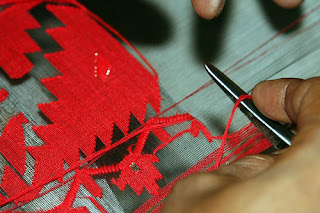Introduction to Shikargah Banarasi Sarees:
Resonant with the traditional theme of the royal hunt, the Shikargah silk sarees from Banaras are breathtakingly beautiful pieces of pure art on silk. Featuring animal & bird motifs, they are Benarasi weavers’ tribute to the ‘shikar’ of yesteryears. Repeated seamlessly all through the saree, these designs are historic and hold a special place in today’s times. The quality of the fabric and the weave matches the finest found in historic times, representing a culmination of a new wave of reviving the rich cultural heritage weaves of India.
Weavers of Shikargah Sarees:
The weavers of Banarasi Shikargah sarees are believed to have migrated to India, and Banaras, from the region around Persia which is the present-day Iran or even further north, from Central Asia. With them came not only the technique of brocade weaving but also the vocabulary of motifs and their style of rendering floral and animal images. A characteristic motif of Banaras brocades, the shikargah or hunting scene, typically illustrates hunters on horseback or on elephants, wielding guns, and pursuing deer and tigers. This scene is the staple of medieval Persian decorative arts including carpets, fabrics, metalware and ceramics and is adopted beautifully in Banaras on these gorgeous silk sarees.
There are only a handful of weavers in Banaras who have picked the complex art of Shikargah from their ancestors and have a rich vocabulary of motifs as an inheritance. Over decades of training, they have gained the knowledge and knack of how exactly these motifs would be translated into the warp and weft through the insertion of extra patterning threads in silk or zari, simultaneously being aware of the wearer’s body and the cultural requirements of modesty, all the while bringing freshness into a traditional theme without being tediously repetitive.
Weaving Process of Shikargah Sarees:
Banarasi brocade weave follows anaqsha, loosely translated as plan, model or pattern and the weavers who plan it are called naqshaband As shikargah is a highly skilled art with very minute and intricate patterns, only a handful of weavers who have been practicing the art since ages are involved in its making. Complete information is required in rendering a shikargah pattern on the loom and creating a brocade fabric. An incorrectly rendered naqsha results in a misshapen woven motif, appearing inappropriately on the finished fabric, leading to wasted material, time, effort and, ultimately, financial loss.
Brocade weaving is a complex process carried out in various steps. First, the design that features on the textile is made on graph paper. Then the yarn is readied for the warp and weft. Then the warp threads are opened up and attached to the loom. The weft yarn is reeled onto bobbins using special equipment. Once the warp and weft are ready, the weaving is done on Jaal loom.
Current Trends in Shikargah Sarees:
Adapting to the unique scheme of the sari, the hunting scene in Shikargah sarees often forms the body of the garment with matching borders and pallu, integrated with other elements of Persianate origin such as the tree of life and pomegranate flowers. Sometimes, the hunting scene detail is weaved in the pallu alone, with the mounted hunter and animals tightly packed into a paisley and repeated along the width of the sari. Yet another rendering is the arrangement of animals and hunters in a lattice layout filling the body of the sari, bringing fresh drama while using familiar motifs. The weavers of Banaras keep experimenting with the looks of the saree based on the occasion and the cost factor involved.
Contrary to the common belief of Persian inheritance of shikargah or hunting scenes, itis not rigidly adhered to in theShikargahsareesmade today. Alert to the taste of patrons, then aqshabands have imbibed elements from diverse sources such as Chinese and Ottoman brocades and European wallpaper designs, setting newer trends while pushing for traditions.

























